Planning your first trip to the UK is an exhilarating experience. From the royal buzz of London to the ancient mists of the Scottish Highlands, the United Kingdom offers a lifetime of "pinch-me" moments. But before you can order your first proper fish and chips, there's a new planning step to cover: the UK's Electronic Travel Authorisation (ETA) system.
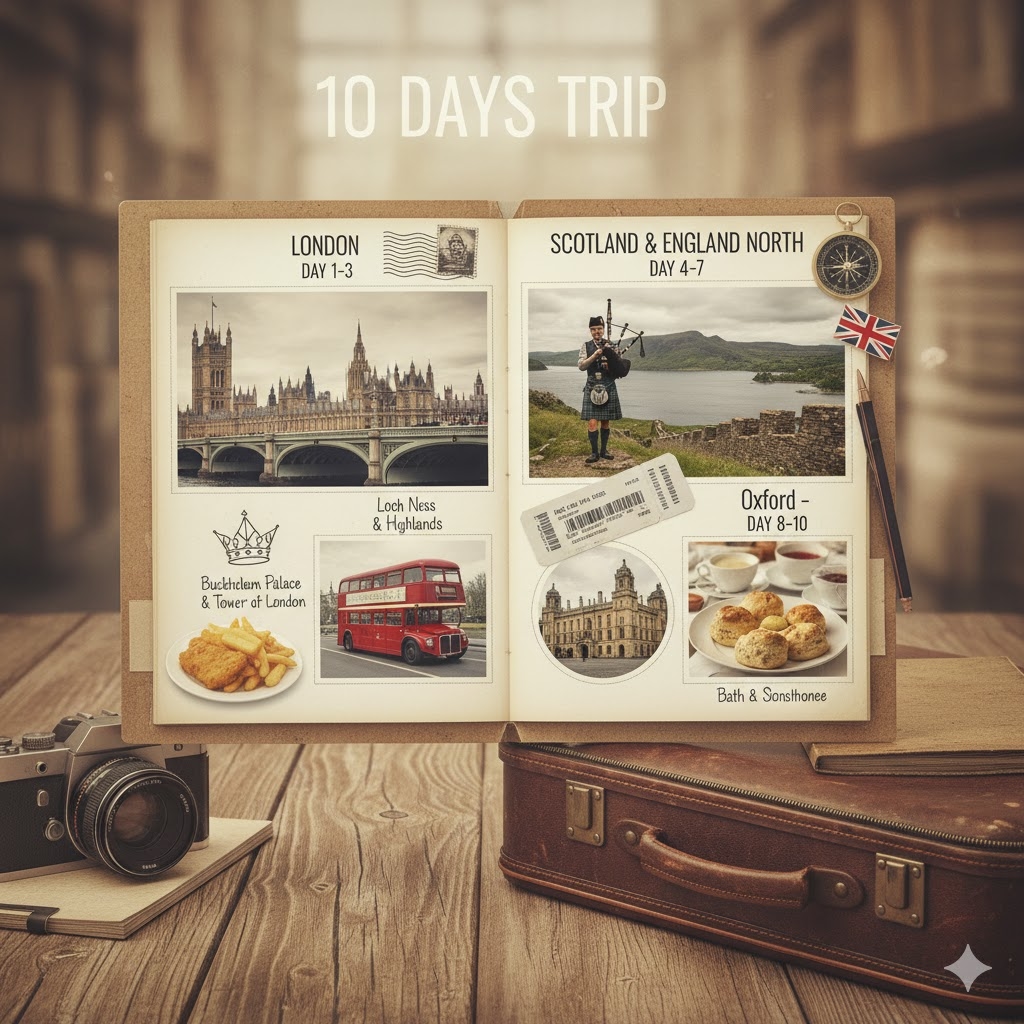
This guide will walk you through everything you need to know, from securing your Online UK ETA to a perfectly paced 10-day itinerary that gives you a fantastic taste of England and Scotland.
What is the UK Electronic Travel Authorisation (ETA)?
Think of the ETA as a digital "hall pass" for your trip. It's not a visa, but a new requirement for travellers who don't need a visa to visit the UK (like those from the US, Canada, Australia, and all EU countries). It's a simple online pre-screening that links a digital permission to your passport, making border crossings smoother and more secure.
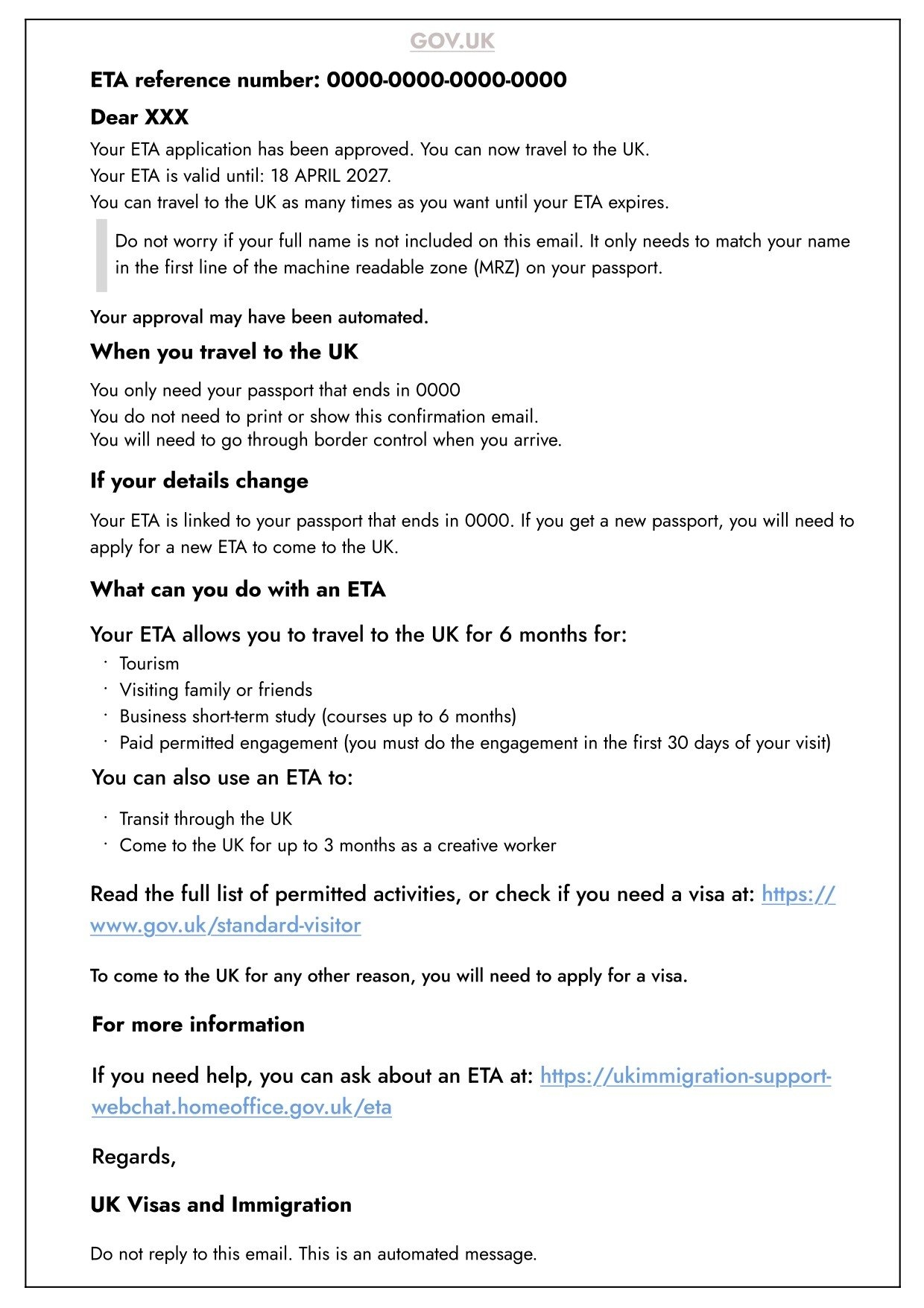
Do I Need a UK ETA or a Visa?
This is the most common question! Here’s the simple breakdown:
You likely need an ETA if you:
Are visiting the UK for tourism, family visits, or short-term business for up to 6 months.
Are from a country that is "visa-exempt" (this now includes the USA, Canada, Australia, New Zealand, and all European Union countries).
Previously I didn't need any pre-travel permission to visit.
You still need a VISA if you:
I plan to work in the UK.
I intend to study for longer than 6 months.
Are from a country that is on the UK's visa-national list.
The UK eTA Application simplifies short-term travel, it doesn't replace long-term visas.
How Do I Apply for a UK ETA?
The process is designed to be quick and painless.
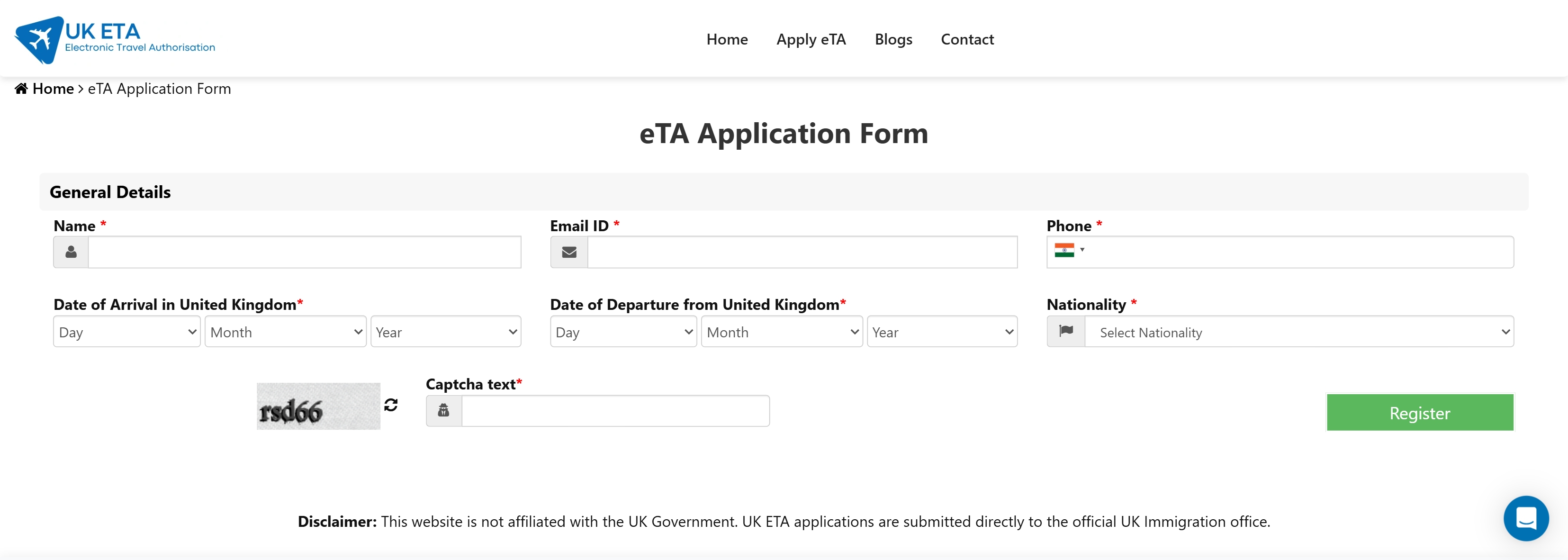
Scan Your Passport: You'll use your phone's camera to scan the photo page of your biometric passport.
Take a Liveness Scan: You'll scan your face as prompted by the app (this is to verify you are the passport holder).
Answer a Few Questions: You'll need to provide your email address and answer some basic questions about your travel plans and any criminal history.
Pay the Fee: The application costs .
How Long Does the UK ETA Take to Process?
While many applications are approved very quickly (sometimes within hours), the official guidance is to allow up to 3 working days for a decision. My advice? Apply at least two weeks before your flight to avoid any last-minute stress.
How Long is a UK ETA Valid For?
Once approved, your ETA is valid for two years. During this two-year period, you can make multiple trips to the UK. If your passport expires within those two years, your ETA expires with it, and you will need to re-apply with your new passport.
The Perfect 10-Day UK Itinerary for First-Timers
With the planning admin out of the way, let's get to the fun part! This itinerary is fast-paced but efficient, using the UK's excellent train network to connect three iconic locations: London, Bath, and Edinburgh.
Days 1-4: The Royal Heartbeat (London)
Welcome to London! Arrive at Heathrow (LHR) or Gatwick (LGW), grab an Oyster card for the Tube (the subway), and head to your hotel.

Day 1: Arrival & Royal Stroll. Settle in, then take a walk through Green Park to the gates of Buckingham Palace. Cross into St. James's Park for classic views, ending at Trafalgar Square and the lively Covent Garden for dinner.
Day 2: History & Crown Jewels. Start your morning at the Tower of London. Get there early to see the Crown Jewels before the crowds, then walk the ancient walls with a Beefeater guide. Afterward, walk across the iconic Tower Bridge for that perfect photo. In the afternoon, explore the British Museum (the Rosetta Stone is a must-see).
Day 3: Parliament & Culture. Begin at Westminster Abbey, the site of coronations and royal weddings. From there, it’s a short walk to the Houses of Parliament (to see Big Ben) and a stroll down Whitehall. Spend your afternoon in South Kensington, choosing between the V&A Museum (design & art) or the Natural History Museum. Catch a West End show in the evening!
Day 4: Markets & A New View. Explore a different side of London. Wander the colourful stalls of Borough Market for a foodie's dream lunch. In the afternoon, take in the 360° views from the London Eye or The Shard.
Days 5-6: Georgian Grandeur & Ancient Stones (Bath)
Take a morning train from London Paddington to Bath Spa (approx. 90 minutes).

Day 5: Roman Baths & City Wandering. Check into your hotel and head straight for the magnificent Roman Baths, one of the best-preserved Roman sites in the world. Spend the afternoon getting lost in Bath's honey-coloured Georgian streets, visiting the Royal Crescent and The Circus.
Day 6: Stonehenge & Departure. In the morning, take a half-day bus tour to Stonehenge. These tours are easy to book from Bath and are the simplest way to see the ancient stone circle. In the afternoon, catch your train from Bath to your next destination.
Wait, where to next? You have a choice. To get to Edinburgh, you can either take a train back to London and catch a high-speed train from King's Cross (4.5 hours) OR fly from nearby Bristol (BRS) to Edinburgh (EDI). The train is more scenic, while the flight is often faster.
Days 7-9: The Mystical North (Edinburgh)
Welcome to Scotland! The capital is a city of two halves: the medieval Old Town and the elegant New Town.
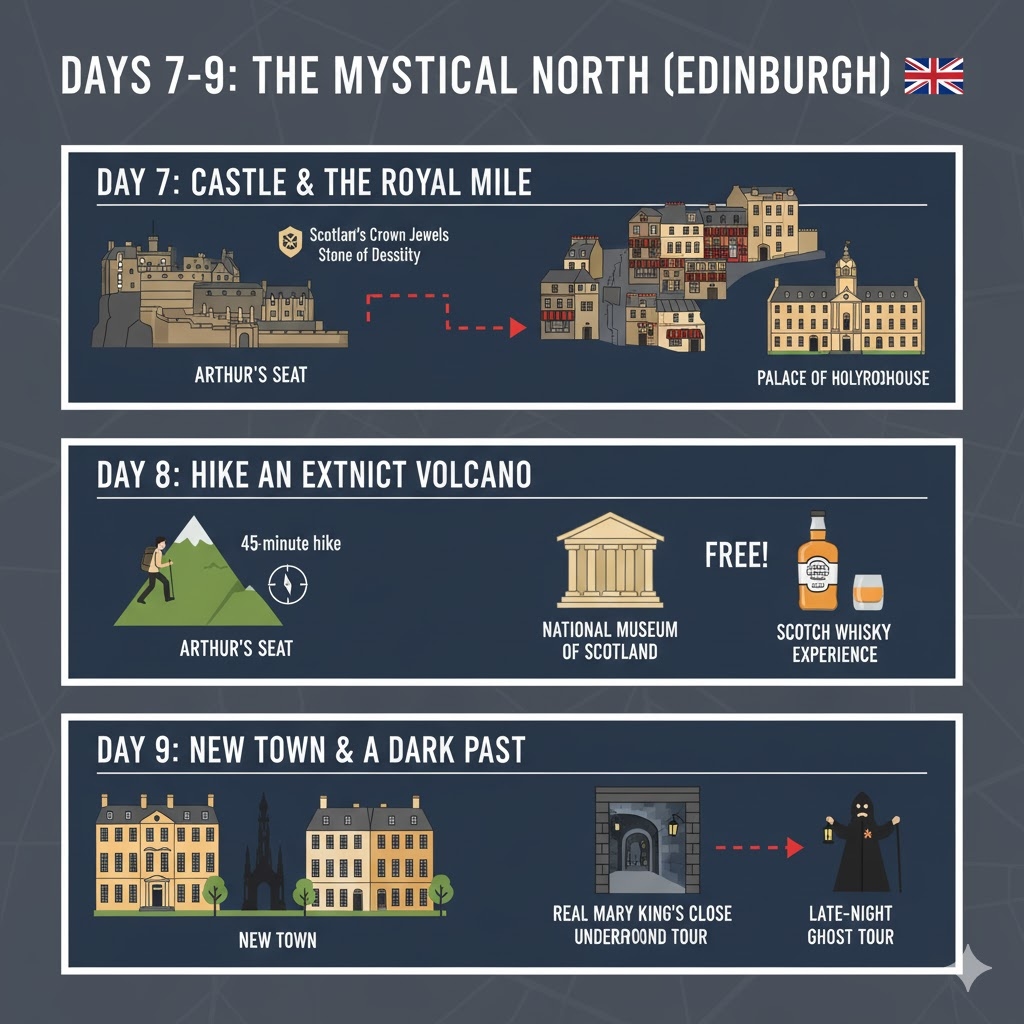
Day 7: Castle & The Royal Mile. Start at the top with Edinburgh Castle, home to Scotland's Crown Jewels and the Stone of Destiny. From there, walk all the way down the Royal Mile, the historic heart of the Old Town. Duck into the many "closes" (narrow alleys), browse tartan shops, and end your day at the Palace of Holyroodhouse, the King's official Scottish residence.
Day 8: Hike an Extinct Volcano. Get the best view of the city by taking a 45-minute hike up Arthur's Seat, an ancient volcano in the middle of the city. The panoramic views are breathtaking. In the afternoon, explore the National Museum of Scotland (it's free!) or do a Scotch Whisky Experience.
Day 9: New Town & A Dark Past. Explore the Georgian New Town, walking down Princes Street (with its beautiful gardens) and the grand George Street. For a spooky thrill, take an underground tour of the Real Mary King's Close or a late-night ghost tour.
Day 10: Farewell, UK!
Enjoy one last full Scottish breakfast (hello, haggis!) before heading to Edinburgh Airport (EDI) for your flight home.
Is 10 Days Enough for a First UK Trip?
Ten days is the perfect amount of time to get a "taste" of the UK. You get the world-class city of London, a slice of historic England in Bath, and a completely different culture in Scotland's stunning capital. You will leave wanting more, which is the perfect reason to plan a return trip!
Common Questions & First-Timer Worries (FAQ)
Here are answers to the most genuine concerns and practical questions first-time visitors have.
What happens if my UK ETA application is refused?
Don't panic! An ETA refusal is not a ban from the UK. It simply means you cannot travel on the ETA scheme. The most common reason for refusal is a mistake on the application or a past criminal conviction. If your ETA is refused, you must apply for a Standard Visitor Visa instead. This is a more detailed application where you can provide more context and documentation.
Should I use cash or card? And what's the deal with tipping?
Money: The UK is a very card-friendly (and "contactless"-friendly) society. You can use a tap-to-pay credit card (like Visa or Mastercard) or a digital wallet (like Apple Pay) for almost everything, from the Tube to a cup of coffee. It's wise to carry a small amount of cash (£50-£100 in pounds sterling) for small shops or tips, but you won't need much.
Tipping: Tipping etiquette is much more relaxed than in the US.
Restaurants: Check your bill! A "Service Charge" (usually 12.5%) is often automatically added. If it is, you don't need to tip extra. If it's not, a 10% tip for good service is standard, but not mandatory.
Pubs: You do not tip for drinks at the bar. If you have a full sit-down meal at a pub, the restaurant rule applies.
Taxis: It's polite to round up the fare to the nearest pound (e.g., £9.50 becomes £10).
What’s the best way to get around? Public transport or rent a car?
For this 10-day itinerary, do not rent a car.
In Cities (London, Bath, Edinburgh): Driving in these cities is a nightmare. They are ancient, with narrow streets, heavy congestion, and extremely expensive parking. They are all incredibly walkable, and London and Edinburgh have excellent public transport.
Between Cities: The UK's train network is fast, efficient, and connects city centers directly. It's far more relaxing than driving on the "wrong" side of the road and worrying about motorways. You only need a car if you plan to explore the deep countryside (like the Cotswolds or Highlands) for several days.
What should I pack for 10 days in the UK?
Think "layers" and "waterproof." The weather is famously unpredictable.
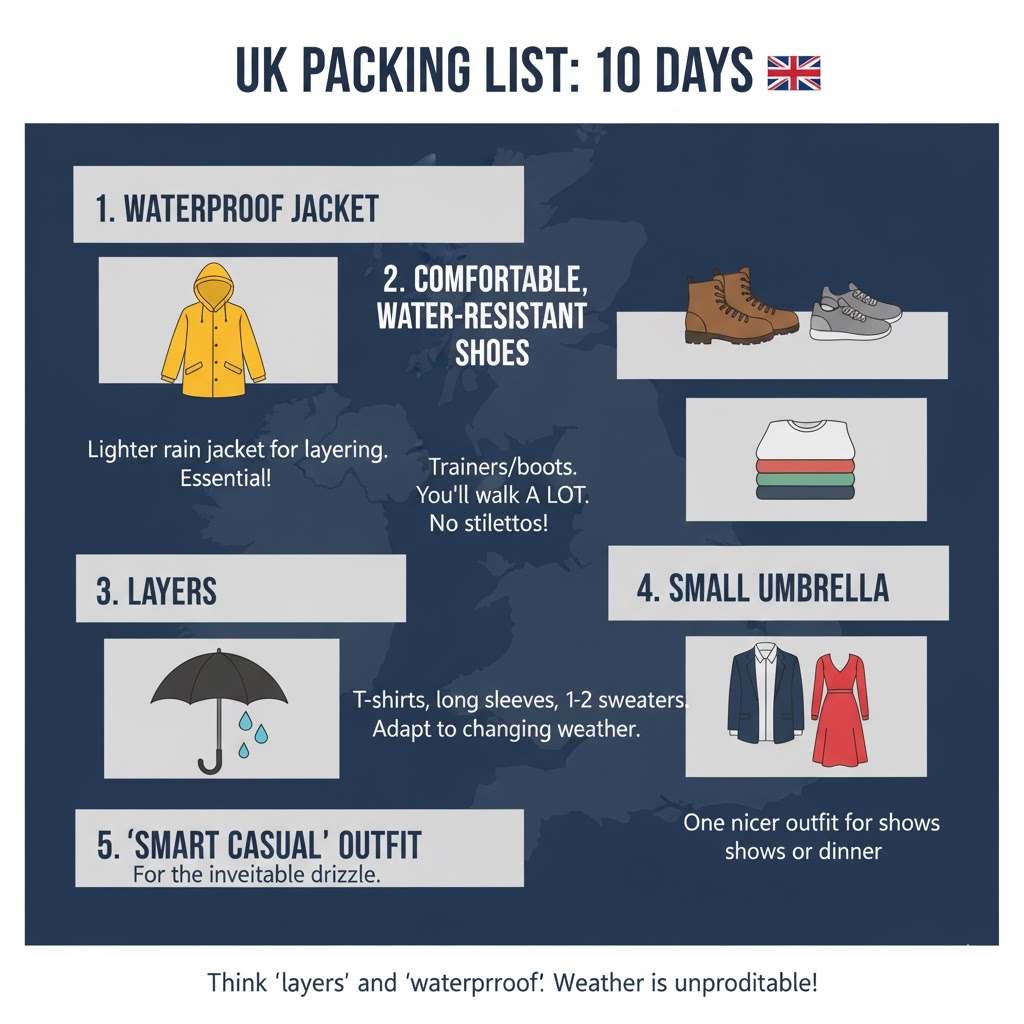
A Waterproof Jacket: This is the single most important item. Not a winter coat, but a lighter rain jacket you can layer over other clothes.
Comfortable, Water-Resistant Shoes: You will walk a lot. Leave the stilettos at home. A good pair of trainers (sneakers) or comfortable boots is essential.
Layers: Pack t-shirts, long-sleeved shirts, and 1-2 sweaters or "jumpers." This allows you to adapt as the weather changes from sun to cloud to rain and back again, all before lunch.
A Small Umbrella: For the inevitable drizzle.
A "Smart Casual" Outfit: One nicer outfit for a West End show or a fancy dinner.
What are the biggest mistakes first-time visitors make?
Over-planning the itinerary. Don't try to see London, the Cotswolds, Liverpool, and Scotland in 7 days. You'll spend your entire holiday on a train. Stick to 2-3 locations, like the itinerary above, to actually enjoy them.
Standing on the left. On any escalator in the UK (especially the London Tube), the rule is STAND on the right, WALK on the left. Stopping on the left will make you very unpopular with commuting locals!
Not booking major attractions in advance. Tickets for the Tower of London, Harry Potter Studio Tour, and popular West End shows sell out weeks or months ahead. Book online before you leave home.
Misunderstanding pub etiquette. You order and pay for your drinks at the bar; there is no table service for drinks. If you want food, find a table (note the number) and then order your food at the bar, giving them your table number.
